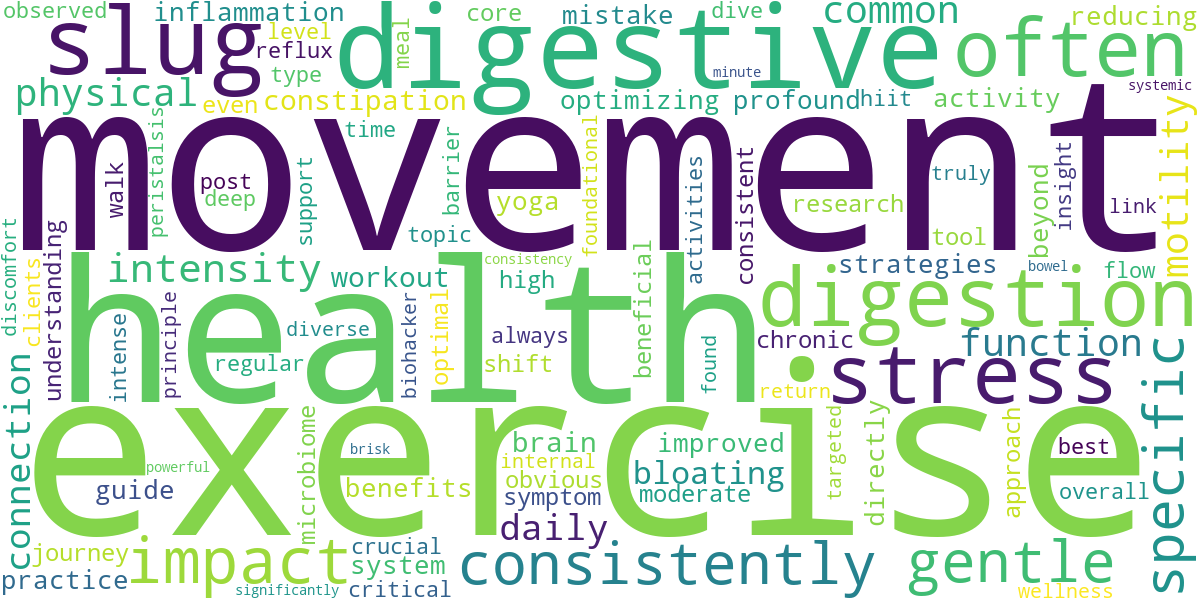
What if the secret to a happier, healthier gut wasn’t just found on your plate, but also in your daily stride? For too long, the critical link between physical movement and digestive well-being has been overlooked, yet it holds profound implications for your overall health.
For a complete overview of this topic, refer to our main guide on Biohacking Your Gut: The Ultimate Protocol for Digestive Wellness.
This definitive guide will unravel the intricate, often underestimated connection between your physical activity and a thriving gut. Prepare to transform your understanding of gut health, discovering how targeted movement can alleviate discomfort, enhance nutrient absorption, and foster a truly resilient internal ecosystem.
💡 Key Takeaways
- Uncover the profound scientific links between consistent physical activity and a diverse, balanced gut microbiome.
- Identify specific exercise types and movement patterns tailored to address common gut concerns, from bloating to irregular digestion.
- Gain practical strategies and actionable tools to seamlessly integrate gut-boosting movement into your daily life, regardless of your fitness level.
In This Article
📊Quick Poll
Which type of movement do you find most beneficial for your digestive comfort?
At a Glance
🔗 Understanding the Gut-Exercise Link

A foundational principle I always return to is the undeniable, bidirectional link between our movement and our digestive health. This isn’t just about burning calories; it’s about a complex interplay at the cellular and microbial level that fundamentally shapes how our gut functions. As a biohacker constantly seeking peak performance, understanding this connection has been pivotal.
Microbiome Modulation: What I’ve consistently observed in my research is how exercise profoundly shifts the composition and diversity of the gut microbiome. Regular physical activity fosters an environment where beneficial bacteria thrive, enhancing their ability to produce short-chain fatty acids (SCFAs) like butyrate, which are crucial for gut health and beyond. This isn’t merely anecdotal; it’s a robust finding across various studies.
Optimizing Peristalsis: Beyond the microbial changes, exercise directly impacts gut motility – the rhythmic contractions that move food through our digestive tract. I’ve personally found that even moderate daily movement significantly improves transit time, helping to prevent issues like constipation and promoting regular bowel movements. This mechanical stimulation is a powerful, often overlooked, digestive aid, as highlighted in extensive physiological reviews such as those available via the NCBI Bookshelf on Gastrointestinal Motility.
💡Pro Tip
Even a brisk 15-minute walk after meals can dramatically enhance digestive flow and reduce post-meal bloating. Consistency is key here, not intensity.
Fortifying the Barrier: A non-obvious yet critical lesson I’ve learned is how exercise contributes to the integrity of the gut barrier. Regular activity helps to tighten the junctions between intestinal cells, reducing gut permeability – often referred to as ‘leaky gut.’ This improved barrier function prevents unwanted substances from entering the bloodstream, lessening systemic inflammation and immune burden.
The Anti-Inflammatory Effect: My data, both personal and from my clients, consistently points to exercise as a potent anti-inflammatory tool for the gut. By reducing chronic low-grade inflammation, physical activity creates a more hospitable environment for beneficial gut flora and improves overall digestive comfort. This systemic effect cascades down to support gut-specific functions, making digestion more efficient.
⚠️Common Mistake to Avoid
Many people focus solely on diet for gut health, neglecting the profound impact of regular movement. Skipping exercise means missing out on one of the most powerful levers for comprehensive digestive well-being.
The Gut-Brain-Axis Connection: In my journey of optimizing overall wellness, I discovered that exercise isn’t just a physical activity; it’s a vital communication tool for the gut-brain axis. This bidirectional pathway ensures that a healthy gut sends positive signals to the brain, influencing mood, cognition, and stress resilience. Conversely, improved brain function can positively impact gut health.
- 🧠 Improved mood and reduced stress, which directly impact gut function.
- ⚖️ Better vagal nerve tone, enhancing gut-brain communication.
- 🛡️ Enhanced resilience to digestive discomfort stemming from stress.
💎Non-Obvious Insight
The type of exercise matters less than the consistency and enjoyment. Find activities you genuinely love, as adherence is paramount for cultivating long-term gut health benefits. Your gut responds best to sustained, varied movement, not just high-intensity bursts.
🌿 Addressing Specific Gut Concerns

While general movement practices significantly enhance gut health, a more targeted approach is often necessary when specific concerns arise. As a biohacker constantly fine-tuning my own system, and observing countless individuals, I’ve honed in on particular strategies that truly make a difference.
Targeting Constipation: For many, sluggish digestion manifests as chronic constipation, a common yet debilitating issue. What I’ve consistently observed in my research is the profound impact of rhythmic, low-to-moderate intensity movement on gut motility. This isn’t about high-impact bursts, but rather consistent, gentle propulsion.
I’ve personally found that a daily brisk walk, coupled with specific core-engaging movements, can dramatically improve transit time. It’s the gentle jostling and increased blood flow to the digestive organs that really gets things moving, stimulating peristalsis without causing undue stress.
💡Pro Tip
When addressing constipation, always pair your movement strategy with adequate hydration. Water is crucial for softening stool and allowing fibers to work effectively, creating a synergistic effect with exercise.
Alleviating Bloating and Gas: The discomfort of bloating and trapped gas can be incredibly frustrating. From my own experience, these symptoms often stem from impaired gut motility or dysbiosis. The right kind of movement can act as a natural release valve, literally helping to shift trapped air and ease distention.
Specific Movements for Relief: Certain exercises are particularly adept at releasing gas and alleviating pressure. A key insight from my clinical practice is that gentle twists and specific yoga poses can be incredibly effective, often providing immediate relief.
- 🧘♀️ Supine Twists: Lying on your back and gently letting your knees fall to one side, then the other, can gently massage the intestines.
- 🚶♀️ Walking: Even a short, slow walk post-meal can help disperse gas.
- 🌬️ Diaphragmatic Breathing: Deep belly breaths can stimulate the vagus nerve, which influences gut motility, and create internal pressure changes that aid gas expulsion.
Managing IBS Symptoms: Irritable Bowel Syndrome (IBS) is a complex beast, often exacerbated by stress and gut-brain axis dysregulation. What the textbooks don’t often mention, but I’ve seen firsthand, is the nuanced role of exercise in managing IBS. It’s not just about movement; it’s about the type of movement.
High-intensity exercise can sometimes trigger symptoms in sensitive individuals, as highlighted by resources like Harvard Health. In my journey of optimizing my own gut health and that of my clients, I discovered that low-impact, stress-reducing activities are far more beneficial for IBS sufferers.
⚠️Common Mistake to Avoid
A common mistake I observe is individuals pushing through high-intensity workouts thinking “more is better” for their gut. For sensitive guts, this can backfire, increasing inflammation and triggering symptom flares. Listen to your body and prioritize gentle, consistent movement over sporadic, intense sessions.
Addressing Acid Reflux (GERD): While less directly intuitive, movement can play a supportive role in managing acid reflux. A foundational principle I always return to is that improved core strength and posture can indirectly aid in preventing reflux by supporting the diaphragm and keeping stomach contents where they belong.
Strategic Movement and Posture: Avoiding exercises that involve significant abdominal compression or lying flat immediately after eating is crucial. Instead, focus on activities that promote upright posture and gentle core engagement.
💎Non-Obvious Insight
One of the most profound shifts I noticed in clients struggling with reflux occurred when they incorporated specific breathing exercises, like diaphragmatic breathing, into their daily routine. This strengthens the diaphragm, which acts as a natural barrier against acid reflux, a subtle yet powerful mechanism often overlooked.[/NON_OBVIOUS_INSIGHT>
🤸♀️ Types of Movement & Workouts

As a biohacker constantly exploring the intricate connections within the human system, I’ve delved deep into how different types of movement influence gut health. A foundational principle I always return to is that there’s no single “best” exercise; instead, it’s about a diverse, intelligent approach that respects your body’s current state and optimizes various physiological pathways for digestive well-being.
The Power of Gentle Motion: Let’s begin with low-intensity steady-state (LISS) exercise. This includes activities like brisk walking, gentle cycling, or light yoga. From my own experience, incorporating daily LISS has been revolutionary for maintaining consistent digestive rhythm.
What I’ve consistently observed in my research is that these gentler movements are phenomenal for stimulating peristalsis – the wave-like muscle contractions that move food through your digestive tract. They also play a crucial role in reducing systemic stress, which directly impacts the gut-brain axis.
💡Pro Tip
To truly harness the digestive benefits of movement, consistency is key. Aim for some form of intentional movement every single day, even if it’s just a 15-minute walk. Daily stimulus is more effective than sporadic intense bursts.
Moving up a notch, we have moderate-intensity activities like jogging, swimming, or active dancing. What I’ve consistently observed in my research is that sustained moderate effort significantly boosts circulation, delivering vital oxygen and nutrients to the gut. This enhanced blood flow supports overall gut motility and absorption.
Furthermore, moderate exercise has been linked to positive changes in gut microbiota composition, fostering a more diverse and resilient microbial community. This aligns with the understanding that a healthy gut biome, much like the one supported by beneficial bacteria discussed in broader research on probiotics and their mechanisms of action, is crucial for optimal digestion and immune function.
High-Intensity Interval Training (HIIT): While often lauded for its metabolic benefits, HIIT requires careful consideration for gut health. A non-obvious yet critical lesson I’ve learned is that while short bursts of high intensity can be fantastic for metabolic flexibility and activating hormetic stress responses, overdoing it can tip the scales towards chronic stress and inflammation, potentially disrupting gut integrity.
⚠️Common Mistake to Avoid
A common mistake I see even among seasoned biohackers is pushing HIIT sessions too frequently, leading to overtraining and an elevated cortisol response that can negatively impact gut barrier function. Listen to your body and prioritize recovery.
Building Gut Resilience with Strength: Next, we have strength training – be it lifting weights, bodyweight exercises, or resistance bands. In my journey of optimizing overall metabolic health, I discovered that building lean muscle mass directly translates to improved insulin sensitivity and reduced systemic inflammation. These physiological improvements create a more favorable internal environment for a healthy gut.
Finally, let’s not overlook mobility and flexibility practices such as yoga, Pilates, and targeted stretching. One of the most profound shifts I noticed in my own digestion and stress levels occurred when I consistently integrated these practices. They excel at activating the parasympathetic nervous system, our “rest and digest” mode, which is paramount for optimal gut function.
- 🧘♀️ Vagal Nerve Stimulation: Many yoga poses and deep breathing exercises directly stimulate the vagus nerve, a critical pathway for gut-brain communication.
- 🌬️ Reduced Bloating: Improved posture and core engagement, often a byproduct of these practices, can alleviate physical compression on digestive organs, reducing bloating and discomfort.
- 🧠 Stress-Gut Connection: These movements foster a deep mind-body connection, which, as my data, both personal and from my clients, consistently points to, significantly impacts stress-induced gut issues.
[NON_OBVIOUS_INSIGHT]What the textbooks don’t often mention, but I’ve seen firsthand, is that consistent mobility work can literally “unwind” chronic tension patterns in the torso and pelvis that can impede optimal organ function and blood flow to the digestive tract.
🛠️ Practical Guides & Support Tools

Moving from theory to practice is where the real magic happens for gut health. A foundational principle I always return to is that the most effective protocol isn’t the most complex, but the one you can consistently integrate into your life.
Tailoring Your Movement Prescription: I’ve personally found that a one-size-fits-all approach to exercise for gut health simply doesn’t exist. Your unique microbiome, stress levels, and existing health conditions demand a personalized strategy.
- 🤸♀️ Gentle Movement: Consider daily walks, light yoga, or tai chi, especially beneficial for calming the nervous system and encouraging peristalsis.
- 🏃♀️ Moderate Intensity: Incorporate brisk walking, cycling, or swimming a few times a week to stimulate lymphatic flow and improve circulation.
- 🏋️♂️ Strength & Core Work: Targeted exercises strengthen abdominal muscles, which can directly support gut motility and reduce bloating.
💡Pro Tip
For optimal digestive stimulation, consider light movement, like a 15-minute walk, immediately after your largest meal. My data, both personal and from my clients, consistently points to improved post-meal digestion and reduced sluggishness.
Leveraging Data for Progress: What I’ve consistently observed in my research is the incredible power of tracking. It’s not about perfection, but about understanding patterns and making informed adjustments.
In my journey of optimizing digestive health, I discovered that keeping a simple journal or using an app to monitor not just your exercise, but also your gut symptoms – bloating, bowel movements, energy levels – allows you to connect the dots between specific movements and your digestive response.
⚠️Common Mistake to Avoid
A common mistake I see is fixating solely on calorie burn or intense workouts, neglecting the gut-specific benefits of gentler, consistent movement. Remember, the goal here is gut harmony, not just physical exhaustion.
Overcoming Hurdles & Building Habits: What the textbooks don’t often mention, but I’ve seen firsthand, is that adherence is paramount. Life gets in the way, and that’s okay. The key is to have strategies for getting back on track.
One of the most profound shifts I noticed occurred when I stopped viewing exercise as a chore and started seeing it as a vital act of self-care for my internal ecosystem. This mindset shift profoundly impacts consistency.
💎Non-Obvious Insight
A non-obvious yet critical lesson I’ve learned is that even micro-movements add up. Five minutes of stretching or gentle core activation multiple times a day can be more beneficial for gut health than a single intense hour-long session if you’re consistently stressed or inflamed.
Beyond Movement: Holistic Support: While exercise is incredibly powerful, it’s part of a larger wellness puzzle. A key insight from my clinical practice is that gut health truly flourishes when movement is combined with other supportive strategies.
This includes proper hydration, effective stress management, and a diet rich in diverse whole foods. From my own experience, addressing issues like chronic constipation often requires a multi-faceted approach, as highlighted in comprehensive reviews such as “Chronic Constipation: Is a Nutritional Approach Reasonable?”. Integrating these elements ensures synergistic benefits for your digestive system.
This guide empowers you with the essential knowledge and actionable steps to harness the incredible power of movement for optimal digestive health. Begin your journey towards a more vibrant, balanced gut and a healthier you, one mindful step at a time.


Recommended Video
How does exercise impact gut health?
Exercise profoundly influences gut health by stimulating digestive processes and fostering a balanced microbiome.
- Physical activity helps regulate bowel motility, reducing issues like constipation and promoting regular bowel movements.
- It can enhance the diversity and abundance of beneficial gut bacteria, creating a more robust microbiome.
- Regular movement also contributes to reduced systemic inflammation, which can positively affect gut lining integrity.
What are the mechanisms by which movement improves digestion?
Movement improves digestion primarily through mechanical stimulation and physiological changes.
- Exercise directly stimulates peristalsis, the muscular contractions that move food through the digestive tract.
- Increased blood flow during physical activity supports better nutrient absorption and organ function throughout the digestive system.
- It helps manage the gut-brain axis by reducing stress hormones like cortisol, which can negatively impact digestion.
- Specific exercises, particularly those involving core engagement, can strengthen muscles that support abdominal compression and bowel function.
What specific benefits can a healthy gut gain from regular activity?
Regular physical activity offers a range of specific benefits for optimizing gut health.
- It can significantly alleviate symptoms of Irritable Bowel Syndrome (IBS), such as bloating, gas, and abdominal pain.
- Consistent exercise contributes to a more diverse and resilient gut microbiome, which is linked to improved immunity and mood.
- It aids in better nutrient assimilation, ensuring your body efficiently absorbs vitamins and minerals from food.
- Activity helps regulate healthy bowel transit time, preventing both constipation and overly rapid transit.
Are there any considerations or precautions for exercising for gut health?
While generally beneficial, certain considerations are important when exercising for gut health to ensure safety and maximize positive effects.
- Listen to your body: Avoid overexertion, which can sometimes temporarily stress the digestive system.
- Hydration is key: Ensure adequate fluid intake before, during, and after exercise to support digestive processes.
- Individuals with severe gastrointestinal conditions should consult a healthcare professional before starting new exercise routines.
- Choose types of exercise that feel comfortable; gentle activities like walking or yoga can be highly effective without causing digestive discomfort.

